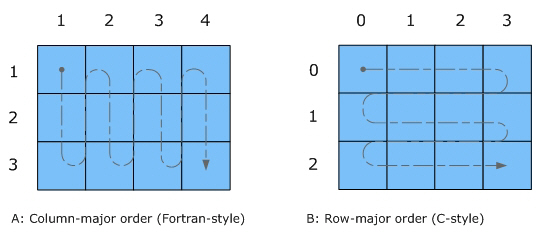Visible to Intel only — GUID: GUID-ABCC618B-43C4-4DCD-ADA2-6F061B5116CD
Visible to Intel only — GUID: GUID-ABCC618B-43C4-4DCD-ADA2-6F061B5116CD
Calling LAPACK, BLAS, and CBLAS Routines from C/C++ Language Environments
Not all Intel® oneAPI Math Kernel Library (oneMKL) function domains support both C and Fortran environments. To use Intel® oneAPI Math Kernel Library (oneMKL) Fortran-style functions in C/C++ environments, you should observe certain conventions, which are discussed for LAPACK and BLAS in the subsections below.
Avoid calling BLAS 95/LAPACK 95 from C/C++. Such calls require skills in manipulating the descriptor of a deferred-shape array, which is the Fortran 90 type. Moreover, BLAS95/LAPACK95 routines contain links to a Fortran RTL.
LAPACK and BLAS
Because LAPACK and BLAS routines are Fortran-style, when calling them from C-language programs, follow the Fortran-style calling conventions:
- Pass variables by address, not by value.
Function calls in Example "Calling a Complex BLAS Level 1 Function from C++" and Example "Using CBLAS Interface Instead of Calling BLAS Directly from C" illustrate this. - Store your data in Fortran style, that is, column-major rather than row-major order.
With row-major order, adopted in C, the last array index changes most quickly and the first one changes most slowly when traversing the memory segment where the array is stored. With Fortran-style column-major order, the last index changes most slowly whereas the first index changes most quickly (as illustrated by the figure below for a two-dimensional array).

For example, if a two-dimensional matrix A of size mxn is stored densely in a one-dimensional array B, you can access a matrix element like this:
A[i][j] = B[i*n+j] in C ( i=0, ... , m-1, j=0, ... , -1)
A(i,j) = B((j-1)*m+i) in Fortran ( i=1, ... , m, j=1, ... , n).
When calling LAPACK or BLAS routines from C, be aware that because the Fortran language is case-insensitive, the routine names can be upper-case, lower-case, or lower-case with the trailing underscore. For example, the following names are equivalent:
LAPACK: dgetrf, dgetrf_, and DGETRF
BLAS: dgemm, dgemm_, and DGEMM
See Example "Calling a Complex BLAS Level 1 Function from C++" on how to call BLAS routines from C.
See also the Intel® oneAPI Math Kernel Library (oneMKL) Developer Reference for a description of the C interface to LAPACK functions.
CBLAS
Instead of calling BLAS routines from a C-language program, you can use the CBLAS interface.
CBLAS is a C-style interface to the BLAS routines. You can call CBLAS routines using regular C-style calls. Use the mkl.h header file with the CBLAS interface. mkl.h includes the mkl_cblas.h header file, which specifies enumerated values and prototypes of all the functions. It also determines whether the program is being compiled with a C++ compiler, and if it is, the included file will be correct for use with C++ compilation. Example "Using CBLAS Interface Instead of Calling BLAS Directly from C" illustrates the use of the CBLAS interface.
C Interface to LAPACK
Instead of calling LAPACK routines from a C-language program, you can use the C interface to LAPACK provided by Intel® oneAPI Math Kernel Library (oneMKL).
The C interface to LAPACK is a C-style interface to the LAPACK routines. This interface supports matrices in row-major and column-major order, which you can define in the first function argument matrix_order. Use the mkl.h header file with the C interface to LAPACK. mkl.h includes the mkl_lapacke.h header file, which specifies constants and prototypes of all the functions. It also determines whether the program is being compiled with a C++ compiler, and if it is, the included file will be correct for use with C++ compilation. You can find examples of the C interface to LAPACK in the examples/lapacke subdirectory in the Intel® oneAPI Math Kernel Library (oneMKL) installation directory.